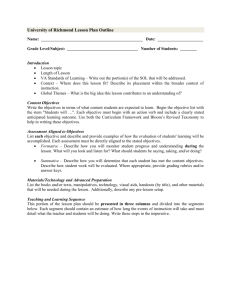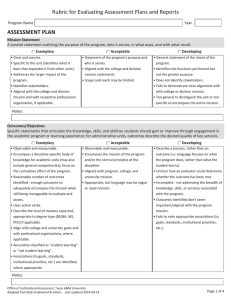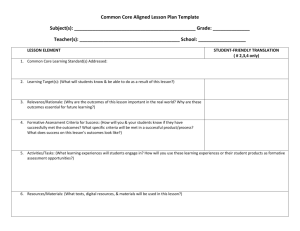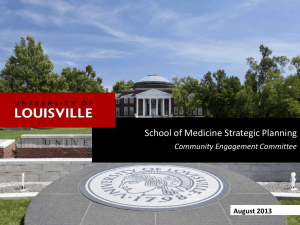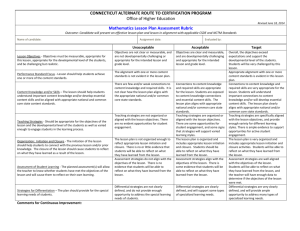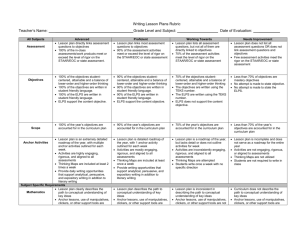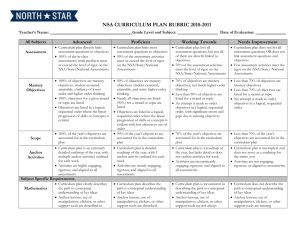Rubric for Evaluating Program Assessment
advertisement
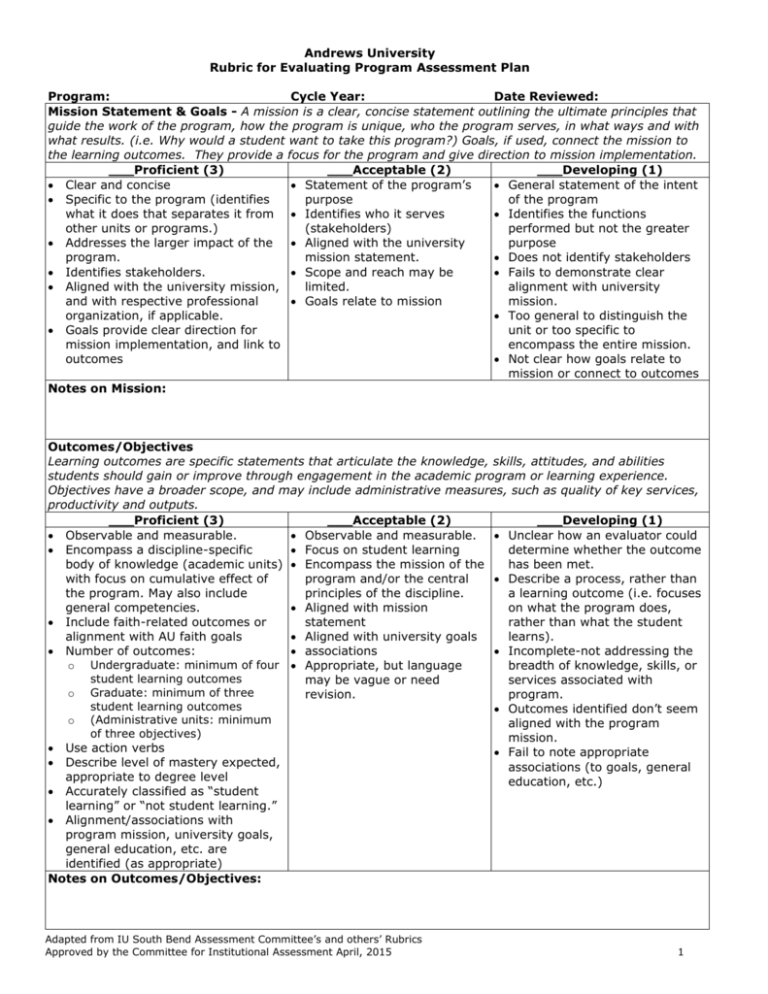
Andrews University Rubric for Evaluating Program Assessment Plan Program: Cycle Year: Date Reviewed: Mission Statement & Goals - A mission is a clear, concise statement outlining the ultimate principles that guide the work of the program, how the program is unique, who the program serves, in what ways and with what results. (i.e. Why would a student want to take this program?) Goals, if used, connect the mission to the learning outcomes. They provide a focus for the program and give direction to mission implementation. ___Proficient (3) ___Acceptable (2) ___Developing (1) Clear and concise Statement of the program’s General statement of the intent Specific to the program (identifies purpose of the program what it does that separates it from Identifies who it serves Identifies the functions other units or programs.) (stakeholders) performed but not the greater Addresses the larger impact of the Aligned with the university purpose program. mission statement. Does not identify stakeholders Identifies stakeholders. Scope and reach may be Fails to demonstrate clear Aligned with the university mission, limited. alignment with university and with respective professional Goals relate to mission mission. organization, if applicable. Too general to distinguish the Goals provide clear direction for unit or too specific to mission implementation, and link to encompass the entire mission. outcomes Not clear how goals relate to mission or connect to outcomes Notes on Mission: Outcomes/Objectives Learning outcomes are specific statements that articulate the knowledge, skills, attitudes, and abilities students should gain or improve through engagement in the academic program or learning experience. Objectives have a broader scope, and may include administrative measures, such as quality of key services, productivity and outputs. ___Proficient (3) ___Acceptable (2) ___Developing (1) Observable and measurable. Observable and measurable. Unclear how an evaluator could Encompass a discipline-specific Focus on student learning determine whether the outcome body of knowledge (academic units) Encompass the mission of the has been met. with focus on cumulative effect of program and/or the central Describe a process, rather than the program. May also include principles of the discipline. a learning outcome (i.e. focuses general competencies. Aligned with mission on what the program does, Include faith-related outcomes or statement rather than what the student alignment with AU faith goals Aligned with university goals learns). Number of outcomes: associations Incomplete-not addressing the o Undergraduate: minimum of four Appropriate, but language breadth of knowledge, skills, or student learning outcomes may be vague or need services associated with o Graduate: minimum of three revision. program. student learning outcomes Outcomes identified don’t seem o (Administrative units: minimum aligned with the program of three objectives) mission. Use action verbs Fail to note appropriate Describe level of mastery expected, associations (to goals, general appropriate to degree level education, etc.) Accurately classified as “student learning” or “not student learning.” Alignment/associations with program mission, university goals, general education, etc. are identified (as appropriate) Notes on Outcomes/Objectives: Adapted from IU South Bend Assessment Committee’s and others’ Rubrics Approved by the Committee for Institutional Assessment April, 2015 1 Measures The variety of measures used to evaluate each outcome; the means of gathering data. Direct measures assess actual learning or performance, while indirect measures imply that learning has occurred ___Proficient (3) ___Acceptable (2) ___Developing (1) A minimum of two appropriate, At least one measure or Not all outcomes have quantitative measures for each measurement approach per associated measures. outcome, with at least one direct outcome. Few or no direct measures. measure. Direct and indirect measures Methodology is questionable. Instruments reflect good research are utilized Instruments are vaguely methodology. Instruments described with described; may not be Feasible-existing practices used sufficient detail. developed yet. where possible; at least some Implementation may still need Course grades used as an measures apply to multiple further planning. assessment method. outcomes. At least one measure used for Do not seem to capture the Purposeful-clear how results could formative assessment. “end of experience” effect of be used for program improvement. the curriculum/program. Described with sufficient detail; No apparent inclusion of specific assessment instruments are formative assessment. made available (e.g., via URL, as attachments, etc.) Specific inclusion of formative assessment to promote learning and continuous quality improvement (e.g., establishes baseline data, sets stretch targets based on past performance, etc.). Notes on Measures: Achievement Targets Results, target, benchmark, or value that will represent success at achieving a given outcome. May include acceptable and aspirational levels. (e.g. Minimum target:80% of the class will achieve acceptable on all rubric criteria; aspirational target: 80% of the class will achieve proficient or better on two-thirds of the criteria.) ___Proficient (3) ___Acceptable (2) ___Developing (1) Target identified for each measure. Target identified for each Targets have not been Aligned with measures and outcomes. measure. identified for every measure, Specific and measurable Targets aligned with measures or are not aligned with the Represent a reasonable level of and outcomes. measure. success. Specific and measurable Seem off-base (too low/high). Meaningful-based on benchmarks, Some targets may seem Language is vague or previous results, existing standards arbitrary. subjective (e.g. “improve,” Includes acceptable levels and stretch “satisfactory”) making it (aspirational) targets difficult to tell if met. Aligned with assessment process rather than results (e.g. survey return rate, number of papers reviewed). Notes on Achievement Targets: Adapted from IU South Bend Assessment Committee’s and others’ Rubrics Approved by the Committee for Institutional Assessment April, 2015 2 Rubric for Evaluating Program Assessment Reports Findings A concise analysis and summary of the results gathered from a given assessment measure. ___Proficient (3) Complete, concise, well-organized, and relevant data are provided for all measures. Appropriate data collection and analysis. Aligned with the language of the corresponding achievement target. Provides solid evidence that targets were met, partially met, or not met. Compares new findings to past trends, as appropriate. Reflective statements are provided either for each outcome or aggregated for multiple outcomes. Supporting documentation (rubrics, survey, more complete reports without identifiable student information) are included in the document repository. Notes on Findings: ___Acceptable (2) Complete and organized. Aligned with the language of the corresponding achievement target. Addresses whether targets were met. May contain too much detail, or stray slightly from intended data set. ___Developing (1) Incomplete information Not clearly aligned with achievement target. Questionable conclusions about whether targets were met, partially met, or not met. Questionable data collection/ analysis; may “gloss over” data to arrive at conclusion. Action Plans Actions to be taken to improve the program or assessment process based on analysis of results ___Proficient (3) ___Acceptable (2) ___Developing (1) Report includes one or more Reflects with sufficient depth Not clearly related to implemented and/or planned changes on what was learned during assessment results. linked to assessment data. the assessment cycle. Seem to offer excuses for Exhibit an understanding of the At least one action plan in results rather than thoughtful implications of assessment findings. place. interpretation or “next steps” Identifies an area that needs to be for program improvement. monitored, remediated, or enhanced No action plans or too many to and defines logical “next steps”. manage. Possibly identifies an area of the Too general; lacking details assessment process that needs (e.g. time frame, responsible improvement. party). Contains completion dates. Identifies a responsible person/group. Number of action plans are manageable. Notes on Action Plans Adapted from IU South Bend Assessment Committee’s and others’ Rubrics Approved by the Committee for Institutional Assessment April, 2015 3 Feedback on Assessment Plan and Report: Thank you for your dedication to data-based decision making in your program. Based on a review by the Assessment Committee, the membership offers the following feedback and advice for the program’s assessment to inform your practice next year. Strengths of the plan: Items needing clarification: Items that need to be added or modified: Feedback for action planning: Adapted from IU South Bend Assessment Committee’s and others’ Rubrics Approved by the Committee for Institutional Assessment April, 2015 4
